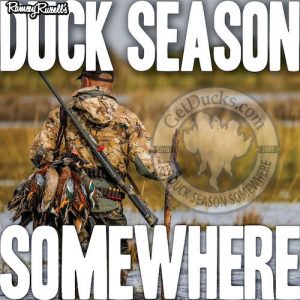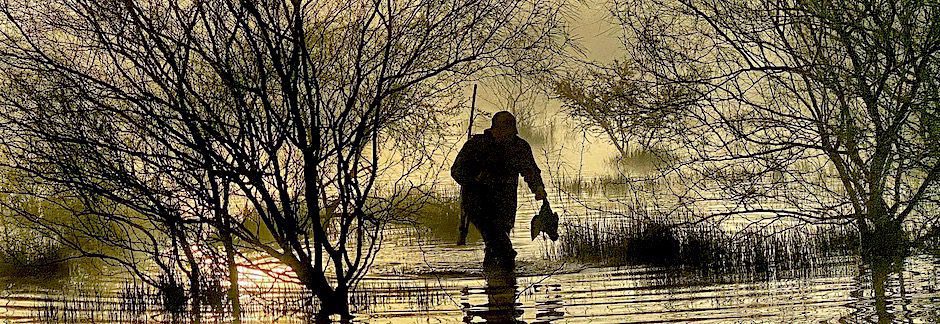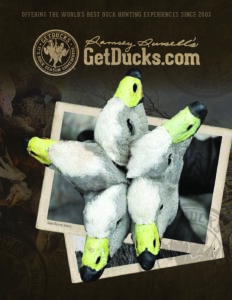MOJO’S Duck Season Somewhere Podcast
EP 241. South-of-the-Border Waterfowl Conservation, Uno

Many iconic North American duck species–some of our most favorite– overwinter South-of-the-Border in Mexico sunshine and wetlands, but what awaits them down there? Is unregulated hunting why we’re shooting so few pintails in the Lower 48?! Eduardo Carrera is a professional biologist and CEO of Ducks Unlimited Mexico (DUMAC). He and Ramsey have a fascinating, in-depth conversation that you definitely do not want to miss! Getting deep into the tules, Carrera covers waterfowl distribution, species, harvests and determining bag limits. A lot of time is spent talking about blue-winged and cinnamon teal, black-bellied and fulvous whistlers, Mexican Ducks and Northern Pintails before wrapping up with fact-based discussions about waterfowl harvest estimates and Mexico’s relatively generous bag limits. Tune in next week as this incredible conversation continues!
Related Links:
EP 240. Bird Flu–Should We Be Worried?

Internet news agencies are adding avian influenza headlines daily, and as waterfowl migrate northwards our social media feeds are streaming with ducks and geese succumbed to bird flu. Should we be worried? What’s bird flu, how long’s it existed, how does it spread, what are its different forms? Why are waterfowl important vectors? Will it be deleterious to waterfowl populations? Dr. Rebecca Poulson is an assistant research scientist at University of Georgia’s College of Veterinary Medicine, Southeastern Cooperative Wildlife Disease Study. Her specialties are virology and wildlife disease. Keeping it simple and conversational, she sheds much needed light on the bird flu topic in today’s highly informative, must-listen episode.
EP 239. When the Levee Breaks

First recorded in 1929, did you know that the acclaimed Led Zepplin song “When the Levee Breaks” was about the Great Mississippi Flood of 1927? On April 21, 1927, following months of unprecedented rainfall throughout a watershed covering much of the United States, the mainline Mississippi River levee crevassed north of Greenville, Mississippi, creating the worse US national disaster until Hurricane Katrina. The event shaped the Delta, Mississippi, national flood control policy. Some claim it even changed America itself. Ramsey Russell and Hank Burdine are both natives of the Mississippi Delta with strong connections to Greenville. Keeping it light and conversational, they meet in the South Delta to discuss this epoch event 95 years later.
Related Links:
A couple really great books have been written on this topic to include Deep’n as It Come: The 1927 Mississippi River Flood and Rising Tide: The Great Mississippi Flood of 1927 and How it Changed America
EP 238. BS’ing at King Chekka BoBo

Just a few minutes from home, Ramsey catches up with long-time friend Johnny McKinion on the antler-strewn front porch of Camp King Chekka Bobo. They cover a lot of interesting ground, about nothing mostly, to include in no particular order deer, ducks, turkeys, Rankin County, Old Charter bourbon, hunting camp rules and traditions, food, family. And after 20-plus years of friendship, Ramsey finally has to ask: what the heck does King Chekka BoBo even mean?! Damned good answer!
237. Waterfowl Habitat Management: Controlling Problem Plants

Managing waterfowl habitat to produce desirable, duck-beneficial moist-soil vegetation combines art, science and sometimes just plain luck because Mother Nature loves throwing curve balls. Kevin Nelms and Ramsey discuss problematic plant species and remedies. As USDA NRCS Wildlife Biologist in the Mississippi Delta, Nelms has spent decades designing and developing numerous private-lands waterfowl impoundments. He’s worked extensively with private landowners throughout the region, improving desirable waterfowl habitat conditions, enhancing duck utilization, even putting together a handbook that Ramsey considers must-have essential for managing waterfowl habitat (refer to related links in the episode description for your own PDF copy). This is the second episode of a 4-part series that duck habitat nerds both new and old will enjoy.
Related Links:
Wetlands Management for Waterfowl Handbook (PDF)
Managing Moist-Soil Impoundments (YouTube)
EP 236. Guatemala Final: Big Al’s Good eats

Food is one of the truest measures of local culture worldwide, maybe even more so among duck hunters. While exploring duck hunting in Guatemala, Ramsey’s hosts made sure he experienced everything the small Central American country had to offer. None more so than today’s guest, Alvaro Aguilar, who has a US background in culinary arts and is the official camp cook. He and Ramsey discuss time spent in the Southern US, classic Guatemalan dishes versus Mexican, why Guatemalan tamales are better, and similarities to the Deep South. Why waterfowl hunting is important to Aguilar strikes familiar cords, but his fearless field-to-table chef adventures takes “eating the whole animal” to a whole ‘nuther level! Y’all DO NOT want to miss his mouth-watering duck recipes. You ain’t going to believe “duck chicarones” and, yes, it was absolutely delicious.
EP 235. Waterfowl Habitat Management: Producing Desirable Moist-soil Vegetation

Spring is in the air, meaning that for many private landowner’s next year’s duck season begins right now–it’s time to start implementing waterfowl habitat plans, whipping those duck holes into shape. But how to begin? Building on previous discussions, Ramsey meets with wildlife biologist Kevin Nelms to discuss moist-soil vegetation management specifics, covering habitat types, natural most-soil vegetation values, water drawdown strategies and plant responses. As USDA Natural Resources Conservation Service’s Wildlife Biologist in the Mississippi Delta, Nelms has spent the past couple decades designing and developing numerous private-lands waterfowl impoundments. He’s worked extensively with private landowners throughout the region, improving desirable waterfowl habitat conditions, enhancing duck utilization, even putting together a handbook that Ramsey considers must-have staple for waterfowl habitat management (refer to related links in the episode description for your own PDF copy).
Related Links:
EP 234. Guatemala Continued: Little Country, Big Surprises

Ramsey continues exploring Guatemala duck hunting culture by visiting with host Andres Collia, discussing how suddenly the trip came together and Guatemala’s famous “eternal spring” like weather. What were Collia’s waterfowl hunting origins in a country with so few hunters? What species are hunted and what are bag limits like in Guatemala? Where do they get most of their hunting gear, guns and ammo? How has American duck hunting influenced Guatemala duck hunting, and how does hunting in his homeland compare to what he’s heard about duck hunting in the US? In this second of 3-part series, a couple duck hunters from different corners of the world talk about these and other topics in an interesting conversation you’ll not want to miss.
EP 233. Are Waterfowl Migrating Like Back in the Good Ol’ Days?

Michael L. Schummer has been an avid duck hunter since way back when. What began humbly enough as a scientific way for putting more ducks over his decoys spawned into a career, eventually leading to his becoming a Senior Research Associate at SUNY ESF, where he conducts myriad waterfowl-related research. Having developed an algorithm that accurately predicts waterfowl migrational timing, he shares with Ramsey reasons that waterfowl migrate — or not. Lots of fun and interesting stories, something to talk about whether you’re sipping cold coffee, looking at empty skies and wondering where in the heck the duck are, or already back at camp early after a barrel-burner.
Related Links:
EP 232. Guatemala: Comparing Both Worlds

During an inaugural exploratory visit to Guatemala this month, Ramsey immersed himself fully into the local duck hunting culture thanks to the help of amazingly hospitable hosts he now regards as family. Though considered a world-class bill fishing destination, this small Central American country was full of many interesting surprises, great food, and blue-winged teal. Today’s conversation with friend Eduardo “Toto” Samayoa is the first of a 3-part Guatemala duck hunting series that proves yet again that birds of a feather flock together, that the world’s a lot smaller–and in some ways a whole lot more similar–than you may otherwise think.








